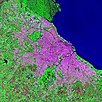Climate Effects on Food Supply

To provide an assessment of potential climate change impacts on world crop production.
|
|
Indicators of Coastal Water Quality
To provide data that can assist in the extraction and analysis of chlorophyll-a concentration and trends from global grids.
|
Anthropogenic Biomes

To provide information on global land use for research on human-environment interactions.
|
|
Intergovernmental Panel on Climate Change
To provide a database with observed responses to climate change for multidisciplinary studies.
|
Environmental Performance Index (EPI)

To provide quantitative metrics for evaluating a country's environmental performance in different policy categories relative to clearly defined targets.
|
|
National Aggregates of Geospatial Data Collection (NAGDC)

To provide tabular data on environmental conditions (elevations, climate, coastal) in which people reside.
|
Low Elevation Coastal Zone (LECZ)

To provide estimates of urban and rural populations and land areas in the low elevation coastal zone.
|
|
U.S. Census Grids

To provide gridded demographic data, including characteristics of age, race, ethnicity, and housing, for the United States and Puerto Rico for data integration.
|
U.S. Census Grids

To provide gridded demographic data, including characteristics of income, education, and housing, for metropolitan statistical areas at a finer resolution than is available in the 30 arc-second grids used for the United States as a whole.
|
|
U.S. Census Grids

To provide gridded demographic data, including characteristics of income, education, and housing, for the United States and Puerto Rico for data integration.
|
U.S. Census Grids

To provide gridded demographic data, including characteristics of age, race, ethnicity, and housing, for metropolitan statistical areas at a finer resolution than is available in the 30 arc-second grids used for the United States as a whole.
|
|
Global High Resolution Urban Data from Landsat

To serve a wide user community by providing composite Landsat images and raw data for urban areas that can be used in interdisciplinary studies of remote sensing and the environment.
|
Intergovernmental Panel on Climate Change

To provide geographical portraits of vulnerability designed to incorporate both exposure to climate change and national capacities to adapt.
|
|
Environmental Performance Index (EPI)

To provide quantitative metrics for evaluating a country's environmental performance in different policy categories relative to clearly defined targets.
|
Compendium of Environmental Sustainability Indicators
To make the acquisition, comparison and analysis of sustainability indicators easier by compiling them in a single database, incorporating multiple country codes, and condensing the indicator descriptions into short methodological summaries in an accompanying data dictionary.
|
|
Compendium of Environmental Sustainability Indicators
To help assess a country's demand on and supply of biological capital.
|
Compendium of Environmental Sustainability Indicators
To provide population estimates, gross domestic product, and surface area data to be used in conjunction with the sustainability indicators included in the compendium.
|
|
Natural Disaster Hotspots

To provide a means of assessing the relative distribution and frequency of global flood hazard.
|
Natural Disaster Hotspots

To provide a means of assessing global landslide mortality risks and distribution.
|
|
Natural Disaster Hotspots

To identify areas of the world that are at greater risk of multihazard total economic loss.
|














